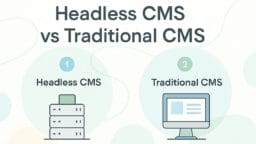Various programming languages become popular from year to year. This year it can be Java, last year it could be C languages. But some languages remain popular for a few years already – look at Python and Swift.
Although they differ from each other, they PYPL statistics shows that these two languages prevail.
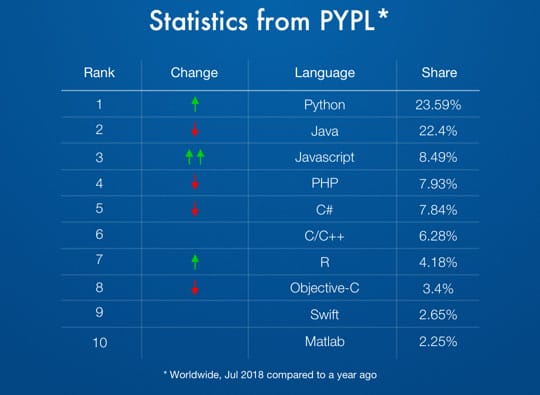
But let’s discuss it more objectively on Python vs Swift and single out strong and weak sides of both languages.
Why is Python Popular?
Python is rather an old language that was created in 1991. Today this language is widely used for FinTech software development, AI-based software, working with Big Data, and other types of software.
It is worth noting that Python is growing fast, there are many relevant tools that enhance the language and make it much more efficient.
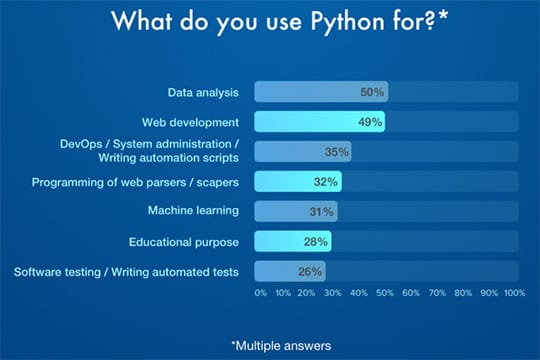
Companies like Netflix and Facebook actively use Python for web development, but the list of big projects is far from being full.
On the picture below you can see what is Python used more for. Let’s proceed to the main cons and pros of Python.
You may like: How Much Does It Cost to Build a Website in 2018?
Strong Sides of Python
Python can boast about a few strong sides it is required to keep in mind for anybody who wants to get acquainted with this language better. Here they are.

Simplicity
 Well, many young developers start using programming with Python since it is rather an easy language. Its code is simple, it can be read easily. Developers can quickly start dealing with it. Moreover, developers can even quickly understand the code written by other developers, that is also very important.
Well, many young developers start using programming with Python since it is rather an easy language. Its code is simple, it can be read easily. Developers can quickly start dealing with it. Moreover, developers can even quickly understand the code written by other developers, that is also very important.
Open Source
 Anyone who wants can make changes in the language code since it is an open-source language. This fact became one of the reasons for such great popularity.
Anyone who wants can make changes in the language code since it is an open-source language. This fact became one of the reasons for such great popularity.
High Integration Level
 Python can function with many languages, that is why it is often integrated into applications created using Java or C language.
Python can function with many languages, that is why it is often integrated into applications created using Java or C language.
Portability
 Also, if there is a necessity to change a platform, no need to change the code base, the Python-based project will surely be functioning properly.
Also, if there is a necessity to change a platform, no need to change the code base, the Python-based project will surely be functioning properly.
A Large Number of Libraries
 As we noted above, Python offers many libraries that can be used for different areas like machine learning or simple web app development. The most popular libraries from Python are Scikit-Learn, TensorFlow, NumPy.
As we noted above, Python offers many libraries that can be used for different areas like machine learning or simple web app development. The most popular libraries from Python are Scikit-Learn, TensorFlow, NumPy.
Recommended for you: 3 Things You Should You Know About Python & Python Developer Salary.
Python Shortcomings
Did you hear about a fly in the ointment that always exists? We would like to note some weak sides of Python to give you a full picture.
Unfriendly to Mobile Apps
 It is possible to create mobile apps using the cross-platform framework from Python, but this app won’t be a full-fledged app. It is much better to use native languages like Java/Kotlin for Android and Swift for iOS to build mobile apps.
It is possible to create mobile apps using the cross-platform framework from Python, but this app won’t be a full-fledged app. It is much better to use native languages like Java/Kotlin for Android and Swift for iOS to build mobile apps.
Design Particularities
 Keep in mind that some specific design restrictions are present in Python. Type of variable is usually detected automatically by Python and it leads to occasional errors from time to time. So developers should remember about it.
Keep in mind that some specific design restrictions are present in Python. Type of variable is usually detected automatically by Python and it leads to occasional errors from time to time. So developers should remember about it.
High Memory Consumption
 Python consumes rather much memory, so it can be rather heavy and slow in some cases, and it is better to choose a lighter competitor.
Python consumes rather much memory, so it can be rather heavy and slow in some cases, and it is better to choose a lighter competitor.
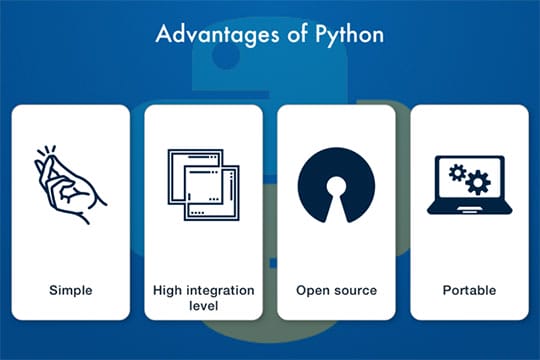
More about Swift
Swift is a very young programming language since it was first released only 4 years ago. Apple built this language to replace Objective-C, and capabilities of Swift make it possible to create mobile apps faster. But first things first.
As you can understand, if this language was created by Apple, then its main goal was to create native apps for the iOS operating system as well as macOS and other devices from Apple.
Such apps like Airbnb, LinkedIn, Lyft and others are created using Swift and it is an indicator of a language’s high quality.
Last year Apple presented Swift 4 to the public, and this year 4.2 version is already available. And this is not the end, of course, Apple has far-reaching plans.
Swift Strong Sides
Swift is the language that can really astonish developers with is advantages. Check them out.
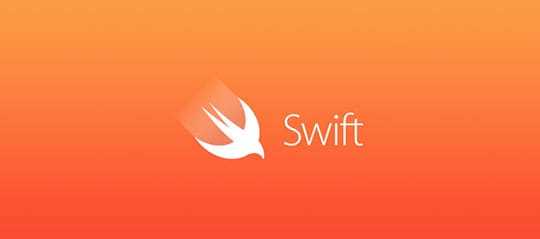
Simplicity
 The same as Python, Swift’s syntax is very simple and it is its first advantage over Objective-C. Developers feel much more comfortable when they write apps using this language. They can also handle with the code written by other developers.
The same as Python, Swift’s syntax is very simple and it is its first advantage over Objective-C. Developers feel much more comfortable when they write apps using this language. They can also handle with the code written by other developers.
Fewer Bugs
 All bugs can be detected before the compilation starts, Swift’s capabilities make it possible. So developers spend less time for revisions and fix all bugs in advance.
All bugs can be detected before the compilation starts, Swift’s capabilities make it possible. So developers spend less time for revisions and fix all bugs in advance.
Memory Control
 Memory usage in the application can be controlled using the ARC tool, and it helps distribute the memory properly. So it saves time and developers pay attention to more important tasks, so the total development time is reduced.
Memory usage in the application can be controlled using the ARC tool, and it helps distribute the memory properly. So it saves time and developers pay attention to more important tasks, so the total development time is reduced.
Open Source
 Swift is also an open-source language, but unlike Python, Apple made it open source only three years ago. First, it was released as a proprietary language. When Swift appeared to be open source, its popularity started growing exponentially.
Swift is also an open-source language, but unlike Python, Apple made it open source only three years ago. First, it was released as a proprietary language. When Swift appeared to be open source, its popularity started growing exponentially.
Capacity
 When Swift turned into open-source language, developers added cross-platform capabilities to this language, so the total potential of Swift was increased. Now you can create apps for Linux and Windows using Swift. Many backend tools can now be combined with Swift.
When Swift turned into open-source language, developers added cross-platform capabilities to this language, so the total potential of Swift was increased. Now you can create apps for Linux and Windows using Swift. Many backend tools can now be combined with Swift.
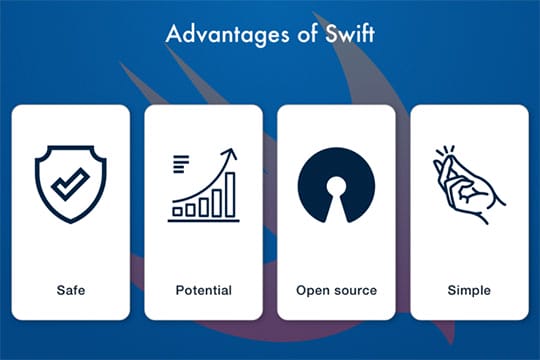
What about the Disadvantages of Swift?
Despite the fact that Swift is a really amazing language, it still has some drawbacks that should be taken into account.
Lack of Skilled Developers
 On the one hand, since Swift is young, there are no so many experienced developers as market demands. On the other hand, it is a profitable solution for a developer who plans to learn Swift – demand for the language is high, and high salaries can be a good motivation.
On the one hand, since Swift is young, there are no so many experienced developers as market demands. On the other hand, it is a profitable solution for a developer who plans to learn Swift – demand for the language is high, and high salaries can be a good motivation.
Lack of Native Libraries
 Swift almost has no native libraries, especially in new versions. In some cases, it may become a serious shortcoming.
Swift almost has no native libraries, especially in new versions. In some cases, it may become a serious shortcoming.
Lack of Stability
 We think it is the largest disadvantage among the listed ones. If developers need to change the code base of a project written in Swift for a more fresh version of the language, they need to write code again.
We think it is the largest disadvantage among the listed ones. If developers need to change the code base of a project written in Swift for a more fresh version of the language, they need to write code again.
You may also like: Introduction to Programming: A Brief of Node JS, Laravel, React, Ruby, Vue & Python.
Python vs Swift: What Should be Your Choice?
We have listed benefits and drawbacks of Swift and Python languages, and you may have a question “so what is better?” Well, although Swift and Python are different languages, they have something in common.
Clear syntax, lack of bugs and quick debugging are the first indicators that help these languages gain the lead.
Both Python and Swift have relevant learning tools that help beginners in software development learn programming faster and easier. You can avail online Swift & Python training beginner courses to kick start your developer journey.
At the same time, Swift has higher performance than Python can boast about. To make the picture more clear, you can check out a picture below to see the comparison of Python vs Swift.
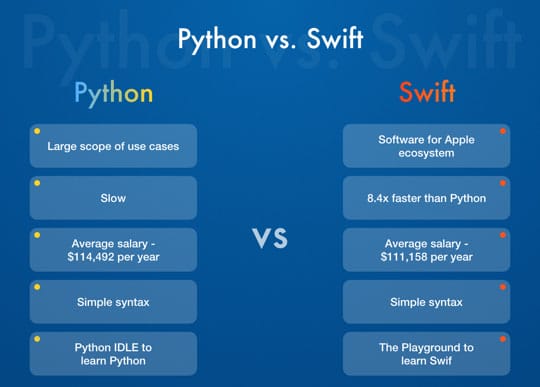
Final Words
Drawing the line on Python vs Swift, we can summarize that everything depends on your specific requirements. Both languages can help you create first-rate software if you use it when needed. So do your best and learn – you will surely succeed!





